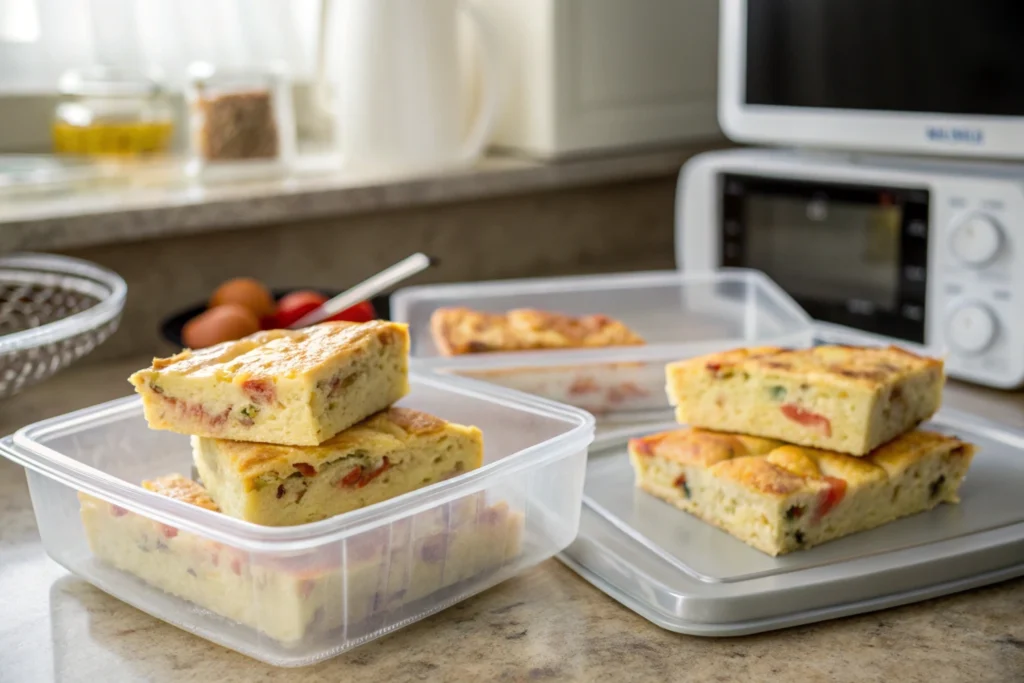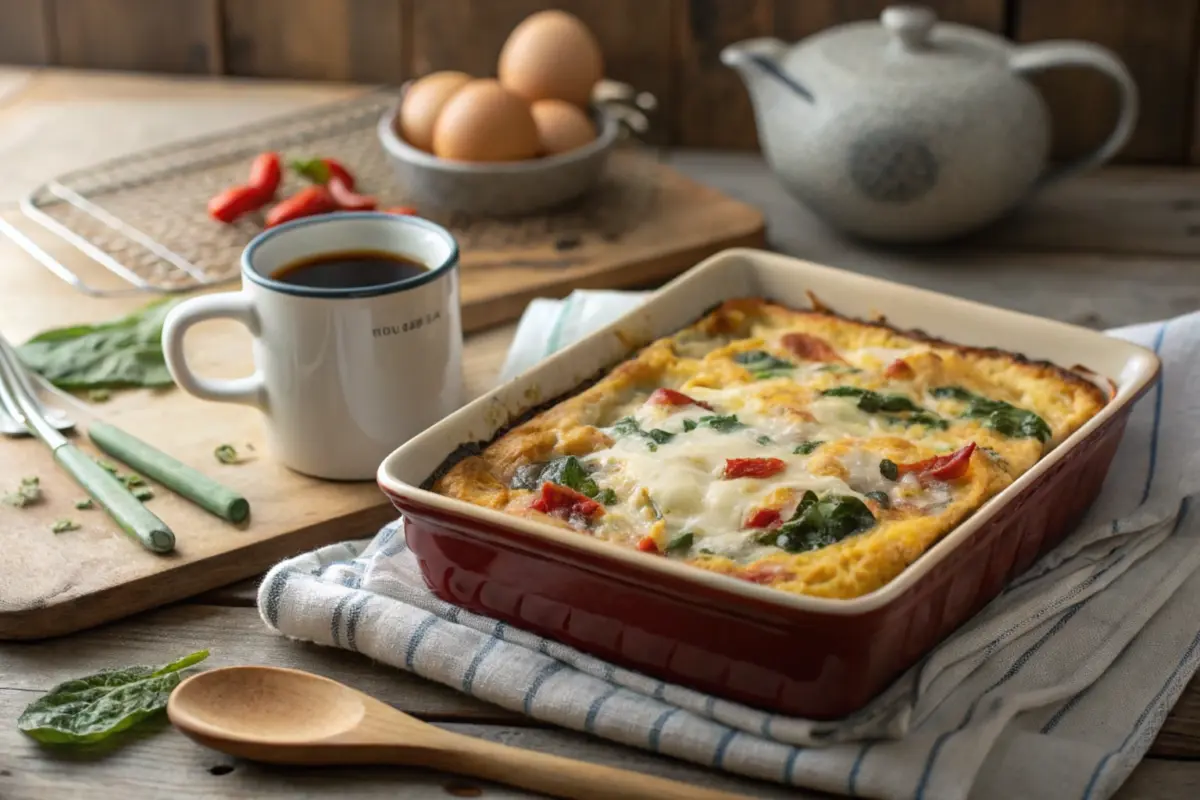Introduction “Why Is My Egg Bake Rubbery?”
Let’s be honest—there’s nothing more disappointing than putting in the effort to make a delicious egg bake, only to pull it out of the oven and find it rubbery. It’s supposed to be fluffy, creamy, and packed with flavor, right? If you’ve ever wondered what went wrong, you’re not alone. Egg bakes are simple in theory but can be surprisingly tricky to get just right. The good news? Fixing this issue is easier than you think. With a little know-how about why eggs behave the way they do when cooked, you’ll be able to avoid the rubbery pitfalls and create a bake that’s soft, tender, and perfect every time. Whether it’s tweaking your ingredients, adjusting your oven settings, or mastering the timing, small changes can make a huge difference. By the end of this guide, you’ll feel confident tackling any egg bake recipe, stress-free.
Understanding the Science Behind Egg Textures
How Eggs React to Heat
Eggs are super sensitive to heat, which is why they’re such a versatile ingredient. When you cook them, the proteins in the egg whites and yolks start to coagulate (a fancy word for solidifying). Too much heat, though, and those proteins tighten up too much, turning your egg bake from tender to tough.
The Role of Protein Coagulation in Texture
Protein coagulation is what helps an egg bake set, but there’s a sweet spot. When proteins cook gently, they trap moisture, creating that soft, melt-in-your-mouth texture. Overdo it, and they squeeze out the moisture—leaving you with a rubbery result. It’s all about balance!
Common Causes of a Rubbery Egg Bake
Overcooking: The Number One Culprit
Let’s face it—most of us have been guilty of overcooking our egg dishes. If your bake stays in the oven too long, those proteins tighten up like a bad hairband. The key is pulling it out just when the center is slightly jiggly. It’ll finish cooking as it cools.
Oven Temperature Inconsistencies
If your oven runs hotter or cooler than it says on the dial, it’s like trying to play darts with a moving target. Invest in an oven thermometer—it’s a game-changer. Keeping your oven at the right temperature ensures your bake cooks evenly and stays tender.
Insufficient Moisture or Dairy Content
Egg bakes need moisture to stay soft. Without enough milk, cream, or a similar ingredient, your bake can dry out faster than toast left in the toaster too long. Dairy, like cottage cheese, can play a key role in softening your bake and adding creaminess.
Ingredient Factors Affecting Texture
Fresh eggs and balanced add-ins like meats, vegetables, or cheeses are crucial. Overloading your bake can throw off the texture. If you’re looking for more inspiration, consider how cottage cheese enhances egg bakes for creamy, moist results.
The Impact of Egg Quality and Freshness
Fresh eggs can make a big difference in your egg bake. When eggs are fresh, their whites and yolks hold together better, creating a smoother texture. Older eggs can lead to a watery consistency, which might affect how evenly your bake sets.
The Role of Dairy in Softening Egg Bake
Dairy is your egg bake’s best friend. Adding milk, cream, or even half-and-half helps balance the proteins in the eggs, resulting in a creamy, tender texture. Too little dairy, and your bake might turn out dense and rubbery. Stick to a tried-and-true egg-to-dairy ratio for the best results.
Balancing Solid Additions: Meats, Vegetables, and Cheeses
While it’s tempting to load up on extras like sausage, veggies, or cheese, too much of a good thing can throw off the balance. Overloading your bake with solids can leave it dense and unevenly cooked. A good rule of thumb is to keep these additions chopped small and evenly distributed.
Baking Techniques to Avoid Rubbery Textures
The Importance of Proper Mixing
Mixing might seem straightforward, but there’s a trick to it. Whisk the eggs and dairy just until combined—you don’t want to overdo it. Overmixing can introduce too much air, which might cause your bake to puff up and then collapse, leaving it tough.
Testing Doneness for Optimal Results
Knowing when to pull your egg bake from the oven is half the battle. Use a toothpick or a knife to check the center—it should come out mostly clean with just a hint of moisture. For further insights on adjusting textures, see our article on what happens when baking with cottage cheese.
Adjusting Cooking Temperature and Time
Low and slow is the way to go. Baking at a lower temperature, like 325°F, allows the eggs to cook gently and evenly. If you’re in a hurry, resist the urge to crank up the heat—it’ll only lead to overcooked, rubbery edges and an undercooked center.
Recipe Adjustments for Perfect Egg Bake
Ideal Egg-to-Dairy Ratios
The magic ratio for most egg bakes is about one part dairy to two parts eggs. For example, if you’re using eight large eggs, aim for around one cup of milk or cream. This ratio keeps things tender without making the bake too runny or firm.
Choosing the Right Pan for Even Cooking
Your pan matters more than you’d think. A glass or ceramic baking dish holds heat evenly, helping your bake cook consistently. Avoid dark metal pans, which can absorb too much heat and overcook the edges.
Tweaking Ingredients for Dietary Preferences
Whether you’re going low-carb, dairy-free, or vegetarian, there are plenty of ways to tweak your egg bake. Swap regular milk for almond or oat milk, or use cooked spinach and mushrooms for a veggie-packed dish. Just make sure any substitutions maintain the right balance of moisture and texture.
Tips for Adding Flavor and Enhancing Texture
The Art of Seasoning an Egg Bake
If you’ve ever asked yourself, “Why Is My Egg Bake Rubbery?” the answer might lie in your seasoning—or lack thereof! A well-seasoned egg bake makes all the difference. Salt is non-negotiable, but adding freshly cracked black pepper, garlic powder, or a dash of smoked paprika elevates the flavor. For an even fresher twist, sprinkle in chopped herbs like parsley or chives just before serving. These small adjustments can transform your egg bake from bland to extraordinary.
Incorporating Moisture-Rich Ingredients Without Overwhelming
Adding ingredients like tomatoes, zucchini, or mushrooms can take your egg bake to the next level, but there’s a catch. If you toss them in raw, they might release too much water and turn your bake into a soggy mess. To avoid this, sauté your veggies first. This step not only reduces excess moisture but also brings out their natural flavors, making every bite more satisfying.
Storing and Reheating Without Losing Quality

Best Practices for Refrigeration
If you want to save leftovers or prep ahead, storing your egg bake the right way is key. First, let it cool completely—this prevents condensation from forming and making it soggy. Then, cover it tightly with plastic wrap or foil. In the fridge, it’ll stay fresh for up to three days. For longer storage, slice it into portions and freeze them individually. Trust me, this makes reheating a breeze.
Reheating Techniques to Retain Tenderness
Reheating an egg bake can feel tricky, but it’s easier than you think. For individual portions, pop them in the microwave at 50% power. This slower approach keeps the eggs from drying out. If you’re reheating a larger portion, cover it with foil and warm it in the oven at 300°F until it’s just heated through. This method helps preserve that soft, fluffy texture you worked so hard to achieve.
Busting Myths and Misconceptions
Debunking Over-Egging for Creaminess
It might seem logical that adding more eggs would make your bake creamier, but that’s not how it works. Too many eggs can actually make the dish dense and rubbery. Instead, focus on the right egg-to-dairy ratio. A good mix ensures a soft, custardy texture every time.
Understanding the Limitations of High-Heat Cooking
High heat might seem like a shortcut to faster cooking, but it’s a risky move with eggs. The edges can cook too quickly and turn rubbery while the center remains underdone. Stick to a lower temperature, like 325°F, and take your time. This approach guarantees even cooking and a tender result.
Frequently Asked Questions
How to keep egg casserole from getting rubbery?
The trick is all in the cooking. Bake it low and slow—around 325°F—and use a proper egg-to-dairy ratio. Adding some sautéed veggies or grated cheese can also help maintain moisture, ensuring a soft and tender texture.
How to make baked eggs not rubbery?
The key is to handle your ingredients gently and bake them carefully. Don’t overmix your eggs and dairy; just whisk until combined. Bake at a lower temperature, and check for doneness early. Pull it out when the center is still slightly jiggly—it’ll set perfectly as it cools.
Why does my egg taste rubbery?
Most of the time, it’s because the eggs were overcooked. When eggs cook too long, their proteins tighten up and squeeze out moisture, leaving them dry and tough. Keeping an eye on the oven and testing for doneness can prevent this from happening.
How do you fix rubbery eggs?
Unfortunately, once eggs are rubbery, you can’t undo it. However, you can salvage the dish by pairing it with a creamy sauce or a fresh side, like a salad or avocado slices. Next time, keep a closer eye on your bake’s cooking time and temperature to avoid overcooking.
Conclusion: Never Wonder Again “Why Is My Egg Bake Rubbery?
Creating the perfect egg bake doesn’t have to be complicated, but it does require a little attention to detail. From understanding how eggs react to heat to balancing your ingredients and baking at the right temperature, every step plays a part in achieving that soft, tender texture. Remember, it’s not just about avoiding mistakes like overcooking or uneven mixing—it’s also about adding the right flavors and techniques to make your bake truly special. With these tips, you’ll not only avoid rubbery results but also create an egg bake that’s creamy, flavorful, and sure to impress. Whether it’s for a cozy brunch or a meal prep staple, you now have the tools to bake with confidence. So, go ahead, try these methods, and enjoy every bite of your perfectly cooked egg bake. You’ve got this, and your oven is ready to shine!

